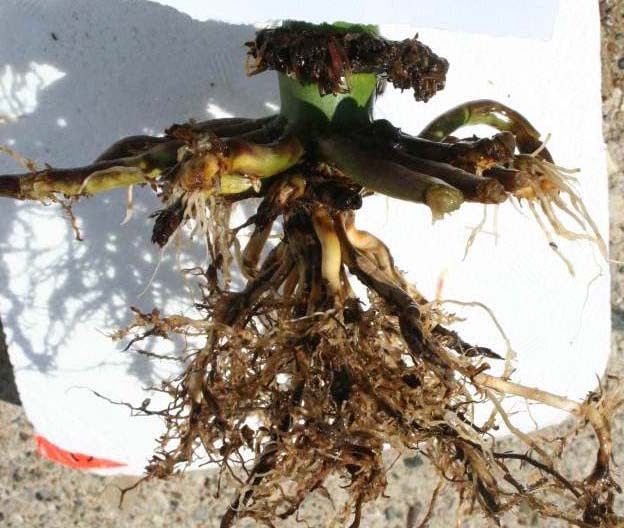Managing resistance
WESTERN CORN ROOTWORM
Ontario does not yet have any confirmed cases of western corn rootworm resistance to Bt corn; however, researchers say that the potential is there, therefore Ontario corn producers need to reconsider their management of this pest in order to prevent such a problem.
According to Dr. Christina DiFonzo, a Field Crops Entomologist at Michigan State University, performance problems with Cry3Bb1 (the first Bt toxin for rootworm control) were first reported in southern Minnesota and eastern Iowa in 2009. Since then, they have seen an increase in the number of fields affected in those two states as well as reports of suspected resistance from fields in Illinois, , Missouri, Nebraska, South Dakota, and Wisconsin.
DiFonzo says fields that have experienced a resistance problem share two key characteristics: multiple years of continuous corn were planted and the same Bt trait (Cry3Bb1) was used. Continuous corn fields typically have a high population of rootworm which creates a higher likelihood for those with any resistance genes to reproduce and develop in future generations.

The situation in the central corn belt is already severe and there is the potential for resistance to develop in the eastern corn belt. Jocelyn Smith, Research Associate, Field Crop Pest Management at the University of Guelph Ridgetown Campus, is concerned the risk may not be taken seriously enough by farmers in southern Ontario. Dr. Art Schaafsma, Professor, University of Guelph Ridgetown Campus and Smith have been working with the Canadian Corn Pest Coalition to monitor resistance to Bt corn in Canada since 2006.
“Although rootworm populations in Ontario are generally smaller than the corn belt in the west, research indicates that the population genetics will not differ significantly, therefore, there is a good chance that the frequency of resistance genes will be similar,” says Smith.
While Smith reiterates that they have not confirmed any resistance cases in Ontario, she also notes that there have been a few inquiries and reports of fields with greater than expected populations in recent years.
There are several differences to our farming practices here in Ontario that may help to slow the development of the Bt resistant corn rootworm. We have more crop diversity, landscape diversity, smaller field sizes, and most farmers practice some form of crop rotation. However, Smith says that with higher corn prices, there has been a trend towards greater corn on corn production. The other troubling factor is the reliance on the same pest control technology year after year.
“We need to think about corn rootworm management as an integrated pest management strategy. We can’t rely on one strategy because this pest is notorious for developing resistance to many control tactics in the past,” says Smith.
Her first recommendation is the most obvious – rotate your crops. “Corn rootworm cannot survive on any other crop. So if you rotate to soybeans in a field that had a high population you are going to successfully manage the pest and eliminate any potential point source of resistance.” Smith says it is important to control any volunteer corn in your soybean field as soon as possible because that could allow for survivors.
Smith also recommends rotating the traits you are using for rootworm control or using a stacked trait instead of relying on single traits to prevent or delay the development of resistance.
The goal is to prevent, or at least delay, the same level of resistance that has developed in the Midwest where farmers have started to use soil insecticides on top of Bt traits. There are several disadvantages to this practice – they are not as selective, there are more risks to the farmers handling the products, and they can mask the symptoms of resistance.
Another aspect of an IPM approach to resistance is to monitor rootworm populations. “We need to go back to scouting,” says Smith, “to make sure the populations even need to be controlled.”
Farmers should be scouting fields in August to determine the number of western corn rootworm beetles they have per plant; one beetle per plant indicates a need to control for corn rootworm in that field in the next year’s corn crop. Farmers cannot rely on winter kill to reduce populations as whether or not western corn rootworm eggs survive the winter depends on the temperature and soil moisture content. They can also survive a wet spring. Tillage does not provide any consistent control of the pest due to the depth at which eggs are laid.
While scouting for populations, you can also look for signs of potential resistance. DiFonzo notes the following warning signs: a large number of beetles in your Bt corn field, leaf feeding or damaged silks that resulted in poor pollination, and unexpected lodging or root damage on Bt plants that cannot be explained by another problem or pest.
Any farmers that have a field with an unusually high population of beetles or high levels of feeding damage on transgenic corn are encouraged to contact any executive members of the Canadian Corn Pest Coalition who are working to investigate and remediate any resistance issues early on. Their contact information is available at: www.cornpest.ca. •






















